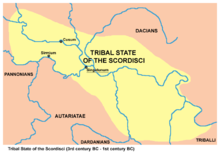Scordisker
The Skordisker (Latin Scordisci ; Greek Σκορδίσκοι, Skordískoi ; Serbian Скордисци) were a Celtic tribe mixed with Thracians and Illyrians on the territory of today's states Serbia and Croatia . They appear for the first time in ancient literature at Strabo . Archaeologically, Celtic influences have been in the area since around 300 BC. Occupied.
history
The Skordiskers fell in the 3rd century BC. In Greece and settled after the defeat at Delphi in 279 BC. Finally settled east of Sirmium , at the confluence of the Danube and Sava . In Belgrade they laid an oppidum on. They played an important role in the settlement of Transdanubia . Strabo distinguished the neighboring large Skordisker and the small Skordisker , both of which are said to have mixed with the local population ( Illyrians and Dacians ), which is confirmed by archeology .
The Germanic Cimbri , Teutons and Ambrons roamed 113 BC. BC during their migration the area of the Skordisker. Since the latter attacked Macedonia several times , they long lived in conflict with Rome . At the turn of the 2nd century BC To the 1st century BC Several Roman governors led campaigns against the Scordisci, so unsuccessfully in 114 BC. Around 12 BC However, the Skordiskers must have submitted to Roman control, which was rewarded with a limited autonomy.
Culture
The Skordiskern was not a purely Celtic tribe. This will u. a. evidenced by excavations that unearthed forms of settlement and house that were untypical for Celtic areas. In the 2nd century BC BC (middle La Tène period ) the Celtic influence seems to be greatest among the Skordiskern. But already at this time, according to the finds, other v. a. Illyrian influences, but also Greek jewelry and weapons. A century later, according to archaeological finds, the Illyrian influence seems to have been considerably stronger. But oriental motifs can also be found during this period.
See also
literature
- Fanula Papazoglu: The Central Balkan tribes in Pre-Roman times: Triballi, Autaritae, Dardanians, Scordisci and Moesians. Amsterdam 1978
- Sladic, Miodrag: Keramika skordiska. Latenska keramika u jugoslovenskom Podunavlju. (Subtitle: The pottery of the Scordisci. The La Téne pottery in the Yugoslav Danubian region ) Beograd 1986.


